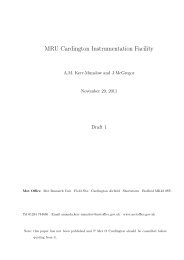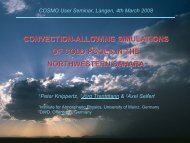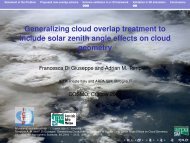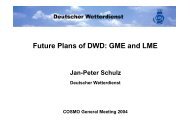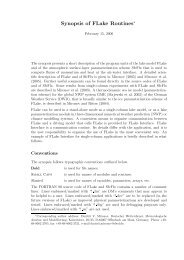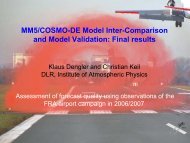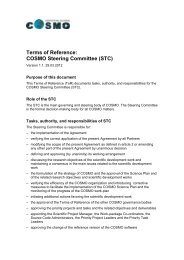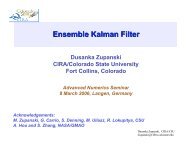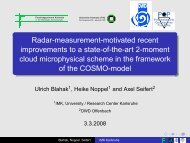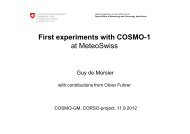document - Cosmo
document - Cosmo
document - Cosmo
Create successful ePaper yourself
Turn your PDF publications into a flip-book with our unique Google optimized e-Paper software.
1 Working Group on Data Assimilation 23<br />
Sensitivity of the LHN Scheme to Non-Rain Echoes<br />
Daniel Leuenberger 1 , Andrea Rossa 2<br />
1 MeteoSwiss, Krähbühlstrasse 58, 8044 Zürich, Switzerland<br />
2 Centro Meteorologico di Teolo, ARPA Veneto, Via Marconi 55, 35037 Teolo, Italy<br />
1 Introduction<br />
Radar-derived quantitative precipitation estimates (QPE) are becoming an increasingly important<br />
element in high-resolution numerical weather prediction (NWP). As such they complement<br />
conventional data like surface or upper-air observations. COSMO has chosen to use<br />
the Latent Heat Nudging (LHN) method (Jones and Macpherson, 1997; Leuenberger and<br />
Rossa, 2003; Klink and Stephan, 2005) to assimilate radar-derived QPE.<br />
In a recent study Leuenberger (2005) systematically investigated the performance of the<br />
LHN scheme at meso-γ scale, both in an idealised setup and in the context of real cases. He<br />
found that LHN has considerable potential at the convective scale in that for an idealised<br />
supercell it successfully initialised the storm in a perfect environment and - to a lesser extent<br />
- in non-perfect environments in which low-level humidity or wind fields were altered. For<br />
the real case convective systems, a supercell and a squall line case, LHN was able to capture<br />
the salient features of the storms. Persistence of the assimilated systems in the subsequent<br />
free forecasts appeared to depend much on the instability of the environment into which the<br />
observed systems were forced.<br />
Unlike conventional observations, radar data exhibit a highly variable quality, in that they<br />
are affected by a number of factors that limit their accuracy in estimating precipitation at the<br />
surface. In the context of assimilating radar-derived QPE in high-resolution NWP models<br />
this poses two salient questions, i.e. how is a specific assimilation scheme affected by errors<br />
in the observations, and how can such variable quality be accounted for?<br />
This paper addresses the first question and presents a sensitivity study of the Latent Heat<br />
Nudging scheme to gross errors in the radar data, notably non-rain echoes. These include<br />
ground clutter returns and spurious signals due to anomalous propagation of the radar beam.<br />
Consideration is given to the dynamical response of the model to the continuous forcing of<br />
idealised and real signals during assimilation time, and to the performance of free forecasts<br />
started from the LHN analyses.<br />
2 Methodology<br />
2.1 Model and assimilation scheme<br />
All simulations are conducted with the LM (Version 3.1) in an idealized mode. The parametrisation<br />
for grid-scale precipitation accounts for four categories of water (water vapour, cloud<br />
water, rain and snow), the mass fractions of rain water (qr) and snow (qs) are treated diagnostically.<br />
Vertical subgrid turbulence and the surface flux formulation are switched on,<br />
whereas cumulus parametrization, radiation and soil processes are switched off. The LHN<br />
scheme used in this study is described in Leuenberger and Rossa (2003).<br />
COSMO Newsletter No. 6




